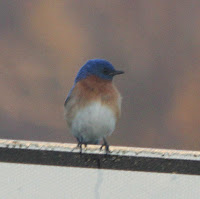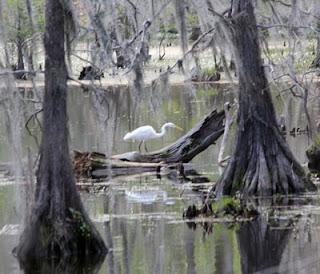The trip home was long but easy — until the last day. All we had to grumble about were the school breaks in Texas and Louisiana which clogged the state parks on weekends. We cruised up the Natchez Trace, enjoying great weather, and survived I-81 through Knoxville and spent a wonderful evening at Lake Claytor State Park in Virginia. Sitting under a tree in shorts watching the lake, we knew that this was the last time for this in a few months. Little did we know….
Tuesday, we decided to cut a day off the trip and made a rather long drive to a Walmart in Pennsylvania where we had stayed before. It was cold and windy but we had a restful night although I did awake once and here a little sleet or something on the roof. Early that morning, we noted that the windows were fogged up and opening the door, saw about three inches of wet snow with snow coming down hard. Of course, all our winter boots and coats were buried in the back of the truck.
After walking the dog — who like us could not believe the conditions — we did some online checking and it didn’t look good. The Walmart folks had big plows going all around us but traffic was moving and the temperature was about 29.
At first, it looked like we’d have to stay. With no wifi, we were checking weather via our IPhones and the forecasts further north looked better. We decided to give it a try.
The first hour or so on I-81 was dicey with tractor-trailers driving like it was July spraying us with slush. We chugged along on wet roads as the salt did it’s thing. After an hour or so, we pulled off in a rest stop — to encounter a jammed exit. A truck had broken down and another, trying to get around it, had got hung up. It looked like we’d be spending hours stuck in line. Fortunately, after about 30 minutes, the drivers got things cleared and we were heading north, into improving weather.

It was a long drive and we were tired when we hit Vermont. The temperatures were just under freezing so I thought (wrong!) that the dirt roads and driveway would be frozen.
We have a tough driveway even in good weather. It’s a situation where once you start up the road with an Airstream, you are committed — there is no place to turn around on the whole road. Well, we started up, regretting it at once as we saw the mud and ruts. We only have to climb several hundred yards and then make a sharp right turn uphill. I got to the turn and knew that we were dead meat – it was way too narrow. Committed, I gave it a try in four wheel drive but soon was completely hung up, with the Airstream completely blocking Wood Road and the truck stuff in the driveway. We were sick.
Soon, traffic began backing up on both sides of us as I tried to find our shovel — which was, like our boots, buried in the back under all sorts of gear. Several guys who live up the hill offered to help and I got my Kubota going and tried to clear out the banks. It was too tight and I came very close to hitting the truck with the bucket, several times. I thought we might be stuck for hours or longer.
Someone suggested trying to pull with the Kubota which does not have chains but is 4WD. We got my logging chain hitched to the front of the Ford, and a neighbor got in the truck to drive it, and very tentatively and slowly, we pulled the truck and trailer out of the road and all the way up the driveway to the top. I couldn’t believe it — and didn’t worry about some bent stuff under the trailer — we can fix that in the spring.

So, after driving 6500 miles or so, the last quarter mile was the worst. We are fortunate to have good neighbors and a tractor that earned its keep. We also learned a good lesson — either leave the Airstream elsewhere or come home later next year. So it may be April in 2012.













